KUBRICK'S LOLITA
A SHOT-BY-SHOT ANALYSIS
PART SIX
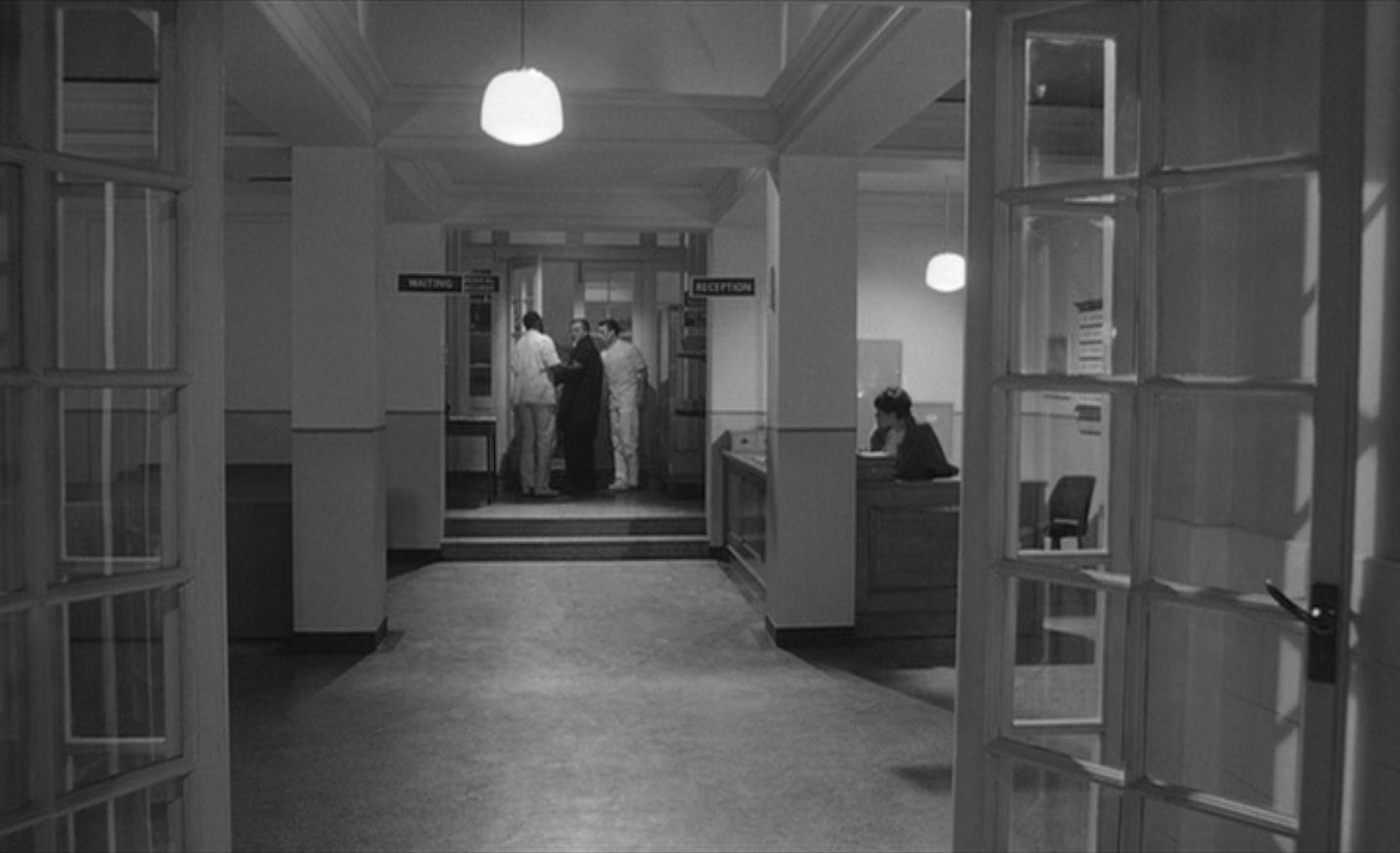
Go to TOC for this film ( (which has also a statement on purpose and manner of analysis and a disclaimer as to caveat emptor and my knowing anything authoritatively, which I do not, but I do try to not know earnestly, with some discretion, and considerable thought).
A NOTE ON THIS ANALYSIS. I COMPARE, SCENE BY SCENE, AT THE END OF EACH, KUBRICK'S FILM WITH NABOKOV'S SCREENPLAY. I HAVE ALSO UNDERLINED THAT DIALOGUE WHICH IS FROM THE NABOKOV SCREENPLAY BUT WHICH IS USUALLY PARAPHRASED. DIALOGUE IN THE FILM WHICH WAS IN THE BOOK, BUT NOT IN THE SCREENPLAY, MAY BE UNDERLINED BUT IS OFTEN INSTEAD OUTLINED IN THE COMPARISON SECTION OF EACH SCENE.
TOC and Supplemental Posts | Part 1 | Part 2 | Part 3 | Part 4 | Part 5 | Part 6 | Part 7 | Films Home
LINKS TO SECTIONS OF THE ANALYSIS ON THIS PAGE:
Trip 2 Begins, Shots 406 through 415
Locations. Newport.
Black Hills and the Badlands, South Dakota Locations. Connection to Dr. Strangelove. CRM-114.
The Gas Station, Shots 416 through 422
More Twists and Turns
Pegasus and Red Lightning
Location of the Gas Station
Reminders of Charlotte's Accident at the Gas Station
The Asiatic Flu, Shots 423 through 431
The Asiatic Flu, Comparing Nabokov and Kubrick
The Drome Ad
Followed! Shots 411 and 412
Examining the Asiatic Flu
Humbert's Arm
Licenses
The Hospital, Shots 432 through 447
The Hospital, Comparing Nabokov and Kubrick
Location of the Hospital
Daedalus and A Portrait of the Artist as a Young Man
You Will have to Terminate this Conversation, Shots 448 through 451
Terminate, Comparing Nabokov and Kubrick
She Didn't, By Any Chance, Leave Any Message For Me?, Shots 452 through 462
Any Message, Comparing Nabokov and Kubrick
Why We Are So Sympathetic with Humbert
The Eyes in Kubrick
Uncle Gustave
The Fence
406 LS of the wagon on the road. (2:00:26)
HUMBERT (narration):
The brakes were relined, the water pipes unplugged...
Crossfade to 407.
407 LS of the wagon on the highway, moving away from the camera. (2:00:33)
HUMBERT (narration): ...the valves ground.
Crossfade to 408.
408 LS of the wagon on the highway, moving away from the camera. (2:00:38)
HUMBERT (narration): We had promised Beardsley School that we would be back as soon as my Hollywood engagement came to an end. Inventive Humbert was to be...
Crossfade to 409.
409 LS of the wagon on a rainy, evening highway. (2:00:43)
HUMBERT (narration):
...I hinted, chief consultant in production of a film dealing with existentialism...
Crossfade to 410.
410 LS of the wagon in the dark. A billboard reads "That Big A is for Action". (2:00:49)
HUMBERT (narration):
...still a hot thing at the time.
Quick crossfade to 411.
Shot 406 | Shot 407 |
 |  |
Shot 408 | Shot 409 |
 | 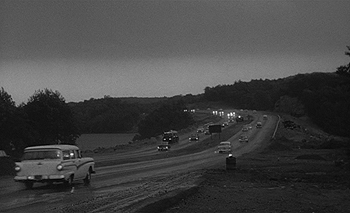 |
Shot 410 | Shot 411 |
 | 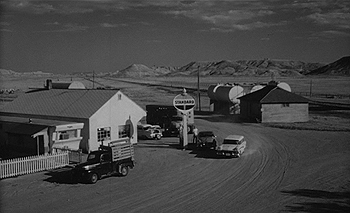 |
411 LS of the wagon in the desert. (2:00:51)
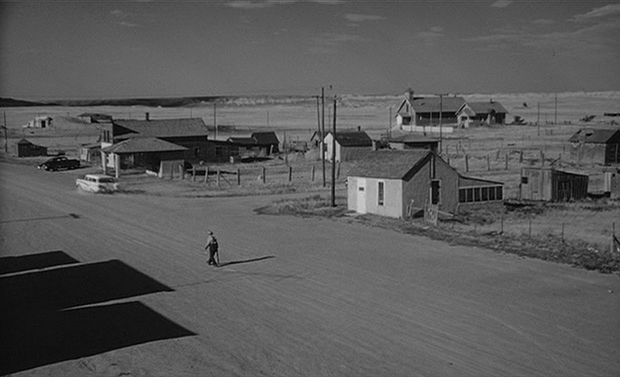
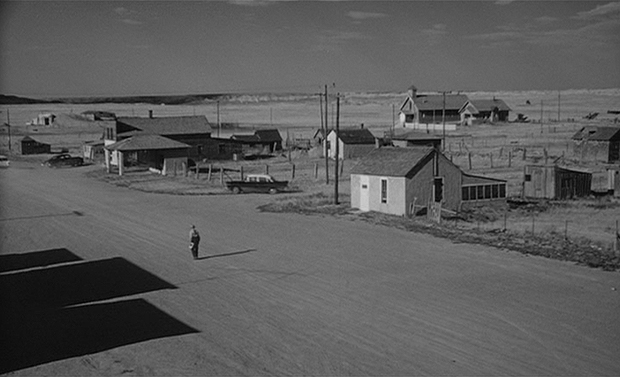
Crossfade to 412.
412 MCU Lolita and Humbert in the car, another car behind. (2:01:08)
Lolita veils her face. Briefly, the music picks up a Middle Eastern flavor, remarking upon her as a harem girl.
Crossfade to 413.
413 LS two cars in the dark. (2:01:38)
414 MCU Lolita asleep on Humbert's shoulder, the other car still following. (2:01:42)
They pass the Black Hills Cafe.
HUMBERT (narration):
I cannot tell you the exact day when I first knew with utter certainty that a strange car was following us. Queer how I misinterpreted the designation of doom.
415 LS of the car speeding past a barn. (2:01:57)
It isn't followed in this shot.
Shot 412 | Shot 413 |
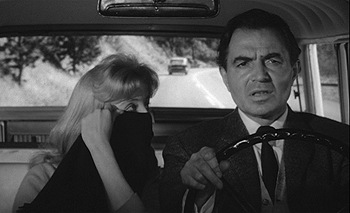 | 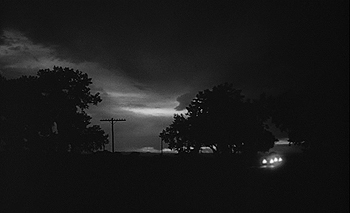 |
Shot 414 | Shot 415 |
 |  |
According to newportbytes.com/film.htm what we're seeing with the beach in shot 407 is Easton's Beach in Newport, Rhode Island. I looked about on Googlemaps and found the location for the beach shot.
For further elaboration on locations that take place in the Black Hills and Badlands and have been located, see Unexpected Lolita Locations - Identifying the Black Hills Cafe and the Badlands of South Dakota (We Are Not in the Southwest). I have identified the Black Hills cafe shot as being in Hill City, South Dakota, shot and 411 as being in Scenic, South Dakota. I also have a section "114, Dr. Strangelove, and Lolita Collide in Scenic" which relates to CRM-114.
Not just information on locations, I've placed analysis of shots 411 through 415 in the separate post given above.
416 LS of the car in a small town. (2:02:02)
Followed by the car again, they pull into a Mobile station and the car passes.
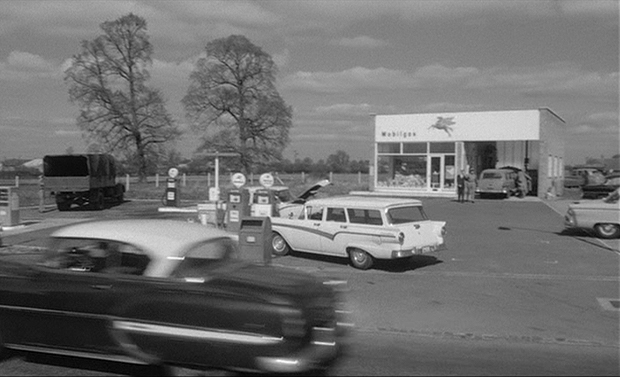
417 MS of the car in the station. (2:02:10)
Lolita and Humbert get out of the car.
HUMBERT (to attendant):
Fill her up, please.
He goes off to the rest room and Lolita strolls around the car.
Crossfade to 418.
418 MS Humbert washing up. (2:02:27)
He notices something outside.
419 LS Through the window of Lolita speaking with the driver of another car. (2:02:33)
License plate 4304 is shown clearly. This is not the same car, however, that has been depicted as following them, with a white top and dark body.
420 MCU of Humbert watching through the window. (2:02:38)
421 LS of Lolita still speaking with the driver of the car. (2:02:40)
422 MCU of Humbert watching through the window. (2:02:49)
Crossfade to shot 423.
Shot 417 | Shot 418 |
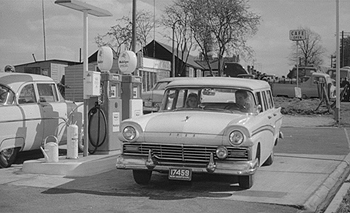 |  |
Shot 419 | Shot 420 |
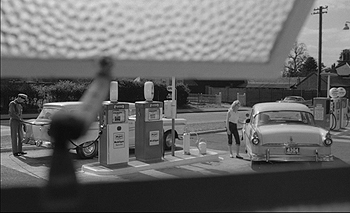 |  |
Shot 421 | Shot 422 |
 |  |
We see Humbert look out the bathroom window. Of course we expect the window to be there, that the bathroom will have a view on the gas pumps, because we have seen Humbert looking out at the pumps in shot 421. However, the situation is impossible.

I imagine Kubrick could have chosen a service station or built a set station that was architecturally appropriate for Humbert looking out the bathroom window at the car. But instead we have a station with no bathroom window where a bathroom window should be. Indeed, there is no bathroom where the bathroom should be. One expects it to be there, however, to satisfy Humbert's looking out the window. So, likely it's not noticed that there is no such bathroom window.
Comparison of this scene with the book is further down the page.
I'm just noting that the red Pegasus may link back to Red Lighting, in The Killing, and the "invisible" horse in Killer's Kiss (see section four) that is present through the film's reference to "The Girl Hunt Ballet".
ReelStreets.com gave the station's location as on London Street in Aston Clinton near Aylesbury, Buckinghamshire. They didn't give an address. I looked about on Google maps and found what is certainly the place though rebuilt. The second view below is across the street from it.
At the gas station, we appear to have a couple of reminders of Charlotte's accident. One is the postal box, which was in front of the Haze household and where, in the book, Charlotte was headed to drop some mail when she was hit by the car. The other one is the army-like truck with the cloth top. This may be the same truck that passed by in the background as Humbert approached Charlotte's body. The only time Lolita has remarked, in the film, about wanting to stop at a gas station, was when she was wanting to call her mother, which is when Humbert told her that her mother was dead. This is the only time we see them at a gas station.
423 LS of the car approaching and going around a curve in the desert. (2:02:49)
As the car goes around the curve, we see the car with the light top and dark bottom again following.
Crossfade to 424.
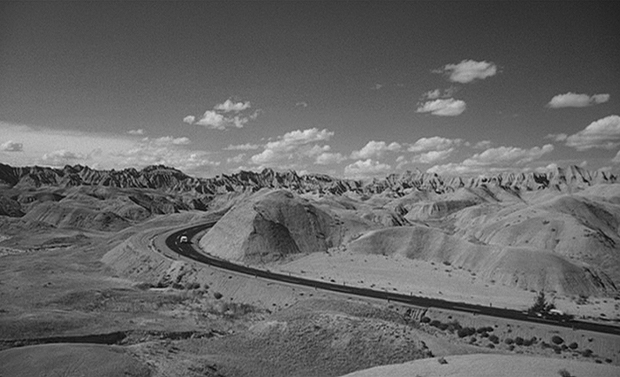
424 MCU Lolita and Humbert in the car in the desert. (2:03:02)
LOLITA:
I'm cold, I'm going to get a sweater.
Climbing into the back seat, she accidentally kicks Humbert's right arm and falls.
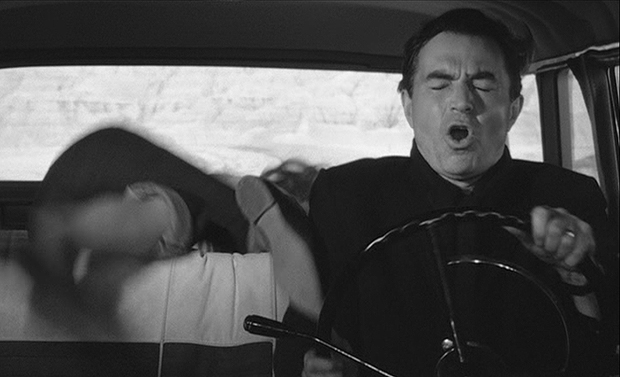
LOLITA: Oh!
HUMBERT: Watch it, please!
LOLITA: Do you have to drive so fast? You'll get us killed! What's the big, fat hurry, anyway?
HUMBERT: There's been a car following us which we've been trying to lose.
LOLITA: What?
HUMBERT:
However, I haven't seen it for the quarter of an hour. I think we've lost it.
LOLITA:
Really?
HUMBERT: I didn't want to scare you, but it's followed us for three days and yesterday it was parked outside the motel.
LOLITA: Oh, I haven't seen any car. Are you sure?
HUMBERT: Yes, I am sure.
LOLITA: I think you're just imagining things.
HUMBERT: What did that man ask you in the service station?
LOLITA: What man?
HUMBERT: There was a man in the service station. I saw you when I was in the john.
LOLITA: I didn't see any man at the... Oh, yes, that man. He wondered if I had a map. I guess he got lost.
HUMBERT: Lo, now listen, please. I don't know if you're lying to me, or if you're insane, and I don't really care any longer, but that man, I believe was the man who was driving the car that's been following us.
LOLITA: Oh, that's ridiculous.
HUMBERT: I think he's some kind of a cop.
LOLITA: A cop?
HUMBERT: Yes.
LOLITA: Well, if he is, the worst thing we can do is let him know we're scared. Let's just ignore him, and slow down.
HUMBERT: Would you kindly tell me, please what you said to him exactly and what he said to you?
LOLITA: I told you.
HUMBERT: Did he ask you where we were going?
LOLITA: All he asked was if I had a map.
HUMBERT: Well I would have thought that he'd ask the man at the service station.
LOLITA: Well, I would have thought he would, too.
HUMBERT: Well, anyhow, I think we've lost him.
425 MCU Lolita as the car blows a tire and throws her. An explosive sound. (2:04:26)
Lolita grips the seat.
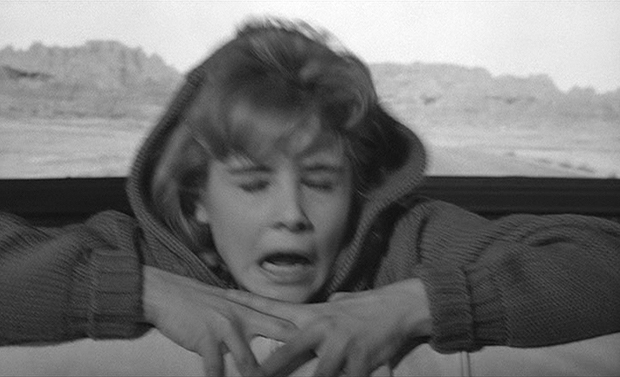
426 MCU Humbert gripping the wheel of the car. (2:04:27)
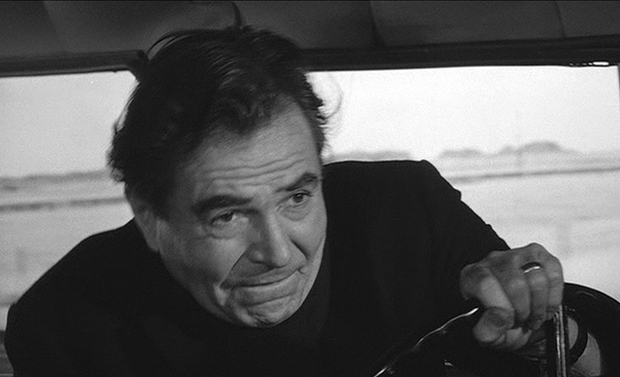
427 LS the car out of control. (2:04:28)

428 MCU Humbert and Lolita in the car. (2:04:31)
Humbert manages to stop the car.
LOLITA:
I told you not to drive so fast!
HUMBERT: Leave me alone, can't you!
LOLITA: Don't talk to me that way.
HUMBERT: Do you think I wanted to have a blow out?
LOLITA: Hey, look, all the nines changed to the next thousand.
HUMBERT: Shhh! There it is.
LOLITA: What?
HUMBERT: The car. Don't you recognize it now?
LOLITA: No.
HUMBERT: Don't look now. I don't want him to think that we've seen him. What's he stopping for?
LOLITA: Maybe he's going to help us.
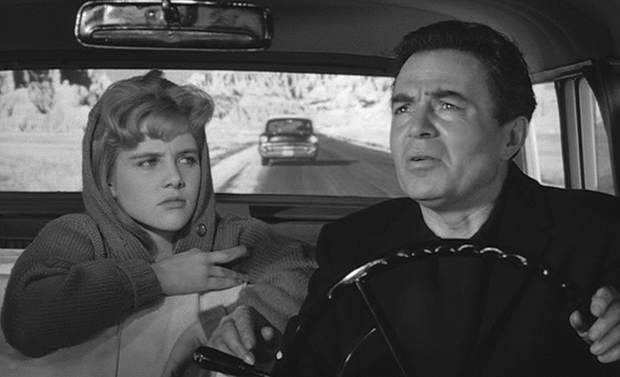
HUMBERT: He can't help us, stopping way back there like that. It can't be the police because if they were the police they'd just drive up beside us and start writing a ticket.
LOLITA: But the police...
HUMBERT: Shut up! I am trying to think. Maybe it's a special kind of police who are just supposed to follow people.
LOLITA: Yeah, like the vice squad! Scaddy, wow!
HUMBERT: Be quiet! Stop talking! We've got to think about this. What are we going to do?
LOLITA: Am I being quiet enough?
HUMBERT: Don't try to be clever, please. I've got a terrific pain in my arm.
LOLITA: Really?
HUMBERT: I don't know what I did to it.
LOLITA: Well, what are we going to do now?
HUMBERT: Well, I'll tell you what I'm going to do, I'm going to get out of this car and walk down the road and speak to him face to face. I'm going to say, "What's all this about? What are you doing?"
LOLITA: I wouldn't do that.
HUMBERT: Why not?
LOLITA: Well, it might be dangerous.
HUMBERT: My arm is killing me. I don't seem to be able to breathe properly.
LOLITA: It's probably just gas pains.
HUMBERT: Yeah, it must be that.
LOLITA: Maybe you ought to see a doctor in the next town?
HUMBERT: No, I'll be all right. It's probably just something I ate.
LOLITA: Wait a minute. I once read in a "Reader's Digest" that this is the way heart attacks start.
HUMBERT: Shut up, will you?
429 MCU Lolita. (2:06:27)
LOLITA: Shut up yourself! I'm tired of hearing about your moans and groans. If you want to know something, I feel pretty lousy myself.
We hear the car behind them start its engine.
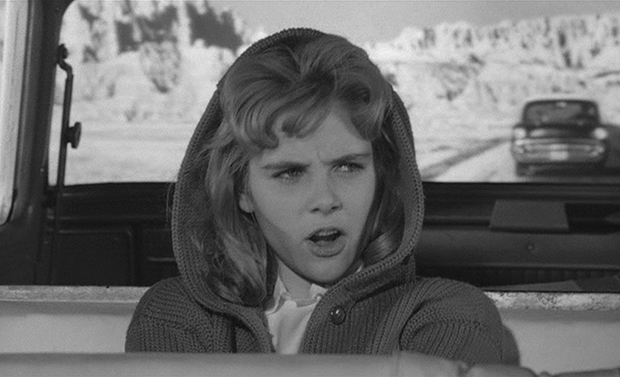
430 MCU Humbert and Lolita. (2:06:36)
HUMBERT: He's moving.
LOLITA: Big deal!
HUMBERT: He's turning around. He's going away.
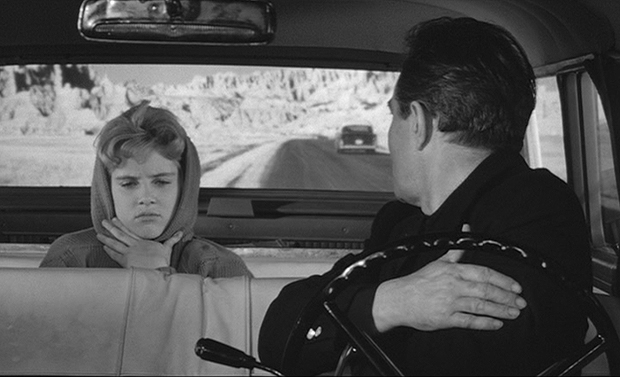
HUMBERT: Are you feeling cold?
LOLITA: Yeah. I feel all achy. I bet I'm getting the Asiatic flu.
HUMBERT: Here, let me feel your head.
431 Humbert feels her head. (2:07:11)
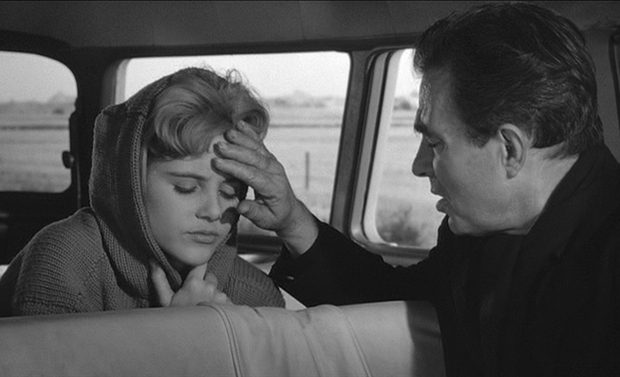
HUMBERT: We make a fine pair, don't we? You just relax and stretch out on the seat, if that will make you feel better and I'll see what I can do about changing the tire.
In the screenplay, after the pair leave Beardsley (which is in Idaho rather than Ohio) Humbert's intention is that they make their way to Mexico via Arizona. Quilty is revealed in the screenplay as following Humbert but takes care to be a "fleet shadow, a ghostly predator...now overtaking...now awaiting his passage." After a description of their travel, the next dialogue that Nabokov provides concerns Humbert staring in the rear view mirror and remarking on how he is certain they are being followed.
The book has the narrative, retained in the film, "The brakes were relined, the waterpipes unclogged, the valves ground and a number of other repairs and improvements were paid for by not very mechanically-minded but prudent papa Humbert...We had promised Beardsley School...that we would be back as soon as my Hollywood engagement came to an end (inventive Humbert was to be, I hinted, chief consultant in the production of a film dealing with 'existentialism,' still a hot thing at the time)."
When they reach the Midwest, at a gas station "under the sign of Pegasus" Humbert briefly loses Lolita but she eventually appears having gone to use the bathroom elsewhere.
Eventually Humbert realizes they are being followed by a red car. He stops for sunglasses and sees a man approach Lolita, who has remained in the car, to speak with her. The man resembles Gustave Trapp, a cousin of his father's from Switzerland. It's after this Humbert and Lolita have the conversation about the man wanting a map. his is followed by the "What did that man ask you?" conversation in which Lolita says he had lost his way and wanted a map. Humbert says he doesn't know if Lolita is lying or insane but they are being followed, he believes by a cop. Lolita notes the odometer's nines having changed to the next thousand. When she was a child, she says, "I used to think they'd stop and go back to nines, if only my mother agreed to put the car in reverse." Humbert realilzes this is the only time she had spoken spontaneously of her pre-Humbertian childhood.
They continue being followed as the days proceed. They pass through Soda, pop 1001.
Having had mail forwarded to Wace and Elphinstone (predetermined destinations) Lolita receives a letter from Mona talking about the play.
As expected, poor Poet stumbled in Scene III when arriving at the bit of French nonsense. Remember? Ne manque pas de dire a ton amant, Chimene, comme le lac est beau car il faut qu'il t'y mene. Lucky beau! Qu'il t'y--What a tongue-twister!
Humbert fears he has lost Lolita in Wace when she disappears for a period of time.
Like a Proteus, the person following them changes from one automobile to another.
They are in Colorado, between Snow and Champion, "the gray mist behind us" deepening and concentrating into a Dominion Blue sedan, when they suddenly "slither" from side to side with a flat. The other car stops some yards behind. Humbert gets out to change the tire, and the car begins to roll slowly away, whether by accident or Lolita's design he doesn't know. He catches up with the car, which Lolita says rolled on its own and that she got it under control. During this, the person following pulls a U-turn and drives away.
There are more pages about tennis and swimming pools and peculiar things happening.
It is outside Elphinstone that, followed still by the shadow car, Lolita says she feels sick, she's dying and wants to stop at a motel at Elphinstone, which was one of her desired destinations. There's no talk of her feeling cold, of the Asiatic flu. There's no blow-out. There's no car following that then turns around. Humbert takes Lolita's temperature and, realizing she's ill, takes her to the hospital.
In the film, the gas station scene is compressed with the earlier one in which Lolita speaks with a man (Quilty) who wants directions. In the film, we have already seen in shot 411 the white car with the dark body is already following, and as it is the one that will pull up behind them when they have a flat, it doesn't seem likely that Quilty would have changed from one car to another and then back to the first car. It seems then, in the film, that Humbert's suspicions over the car at the gas station, that it is the individual following them, would be mistaken. In fact, the car with the white hood and dark body appears to have perhaps continued down the road when they pulled into the gas station.
The 1001 population of Soda, in the book is clearly intended to play off the odometer's all 9s rolling over.
Trapp, in the book, is a play off the idea of a "trap" as well as the Swiss Trapp family singers. The uncle is believed to have been seen at the hotel as well and in the book Humbert states he shares Humbert's proclivities. One time, Humbert believes he sees Gustave watching when Lolita is playing tennis. He's convinced it must be Gustave and his reaction is one of nausea to the point of throwing up. No history is related about Gustave other than the fact he was married to Humbert's father's sister, but obviously a troubling history appears to exist between the two or else Humbert would not be made so physically ill by him, and would not have fixated on the conclusion that it must be Gustave following them. One is led to wonder if Humbert had been molested by Gustave as a child.
I've read discussion on whether or not Humbert's uncle, Ruka, on his mother's side may have been a pedophile, this based on a passage in Nabokov's Speak, Memory.
When I was eight or nine, he would invariably take me upon his knee after lunch and (while two young footmen were clearing the table in the empty dining room) fondle me, with crooning sounds and fancy endearments."
The fondling has been treated by some as referring to sexual abuse. But Nabokov speaks well of his uncle and writes of him lovingly. Perhaps far too much is read into his description of fondling. Yet, from Look at The Harlequins!...
There was also a child of ten or so cradling a large yellow beach ball in her bare arms. She seemed to be wearing nothing bu a kind of frilly harness and a very short pleated skirt revealing her trim things. She was what in a later era amateurs were to call a "numphet." As she caught my glance, she gave me, over our sunny globe, a sweet lewd smile from under her auburn fringe.
"At eleven or twelve," said Iris, "I was as pretty as that French orphan. That's her grandmother all in black sitting on a spread Cannice-Matin with her knitting. I let smelle gentlemen fondle me. I played indecent games with Ivor--oh nothing very unusual, and anyway he now prefers dons to donnas--at least that's what he says."
And...
She had always had a crush on me, oh yes, ever since I used to mesmerize her in my lap, playing sweet Uncle Gasper, muffling every other line, and now all had come back and she certainly wished to do something about it.
I'm loathe to read pellmell into fiction hints of the life of the author, but I too have wondered about Nabokov and if something happened with his uncle that pursued him and made him wish to understand it.
Fondled is a word that Nabokov does use in a sexualized manner. It appears in Lolita before he even meets Lolita, when he believes he will be staying at the home of the McCoos who have a twelve-year-old daughter.
I...spent a fantastic night on the train, imagining in all possible detail the enigmatic nymphet I would coach in French and fondle in Humbertish.
The McCoos were relatives of a former employee of his Uncle Gustave. Instead he ended up with Charlotte Haze as the McCoo's home burned down.
Here's the photo montage of Clare Quilty overlooking Humbert in Lolita's bedroom.
The shadows are long in shot 411 when we are shown Lolita and Humbert being followed. Something about those 3 long shadows in shot 411, when we are first shown Humbert and Lolita being followed resonates (to me) with those three cigarettes sticking out of the Drome pack.
Also making an appearance, with the old man on his cane, is the "What goes on three legs in the evening?" portion of the stock Oedipal riddle.

Nabokov makes so much about these Drome cigarettes in the book that it's difficult to imagine they are only an allusion to Camel cigarettes and there isn't anything else to them. All that I do know is that Kubrick makes parts of the DROME ad on Lolita's wall unreadable as far as we can't tell exactly what's going on visually, it's a collaged image, and we know that hidden within it is a visual reference to the faux psychologist who shows up at Humbert's at Beardsley and talks him into letting Lolita be in the school play. As the psychologist was hidden in the ad, I wouldn't be surprised to have a part of the ad hidden in this scene, such as with the 3 cigarettes.
Kubrick simply may be referring to the DROME ad in Lolita's bedroom just to signal that Quilty is in that car following Humbert.
For further elaboration on locations that take place in the Black Hills and Badlands and have been located, see Unexpected Lolita Locations - Identifying the Black Hills Cafe and the Badlands of South Dakota (We Are Not in the Southwest). I have identified the Black Hills cafe shot as being in Hill City, South Dakota, shot and 411 as being in Scenic, South Dakota. I also have a section "114, Dr. Strangelove, and Lolita Collide in Scenic" which relates to CRM-114.
How to tackle this except to say, "Interesting thing and may warrant attention. But maybe not an interesting thing to some."
In the above linked post I deal with how shot 411, which occurs in Scenic, South Dakota, at Bombing Range Road, relates to Dr. Strangelove and CRM-114.
Now to try to deal with Lolita's Asiatic flu, which isn't in the book, but it seems it would be connected with the TOKYO poster in Lolita's bedroom and perhaps Lolita's speaking of Quilty going by a certain "Oriental" philosophy. The TOKYO poster is an odd one as it shows what looks like the stereotypical (of the time) "Eskimo" (Inuit) standing atop the world. I'm not saying it's not a Japanese poster, it probably is, but I think we've got a couple of things going on here...
There is an easily overlooked section in the book where Humbert goes on an arctic expedition in Canada, which is a wasteland of "blankness and boredom". It was one of the only places where Humbert had no trouble with his obsession with nymphets for, as he wrote, "The plump, glossy little Eskimo girls with their fish smell, hideous raven hair and guinea pig faces, evoked even less desire in me than Dr. Johnson had. Nymphets do not occur in polar regions." Humbert's job was to record the "psychic reactions" of the team to their confinement but he gave this up due everyone's irritation with his questions. Later he learned the real purpose of the expedition was "hush-hush" but had been achieved.
The idea of the arctic is later returned to with the man Lolita marries having arctic blue eyes. Plus, Lolita and her husband, with the arctic blue eyes, are moving to Alaska.
Lolita has on her wall, in the film, a poster of the very type of child to whom Humbert would not be attracted. A curious Kubrick addition.
To continue on, in the TOKYO poster in the bedroom Kubrick has rather given us a glyph that is satisfied in the scene in which Lolita announces she has the Asiatic flu. We have Asia with TOKYO, the cold, artic north with the person (whether Inuit or Japanese) standing atop the world, and we have the hood wrapped around the face.

The TOKYO poster is recalled in the Badlands with Lolita (1) putting on her sweater as she's cold, (2) the hood wrapped up around her face just as the child in the poster has a hood around her face, (3) Lolita stating she believes she has the Asiatic flu, and (4) though Humbert and Lolita are in the desert, the brilliant white of the desert landscape through the car's windows could also be tied with the arctic as it such high contrast that it creates a brilliant white wasteland effect, as if is instead snow.
I'll first comment on the idea of inversion with the high contrast, which I won't cover in full here as I have already discussed it in the Killer's Kiss analysis.
In Cocteau's Orphee, Orpheus is a poet, which will be given as the reason he is able to cross from the world of the living into that of death, which is just another form of being. At the film's beginning, he is present at a cafe when a younger rising poet is killed by Death's motorcyclists. Death, disguised as a princess, had arrived with the younger poet and has him put in her car. Orpheus doesn't know yet that she is Death when she calls upon him to accompany her in her car, transporting the youth who Orpheus believes only to have been injured. She states she needs him as a witness. In the car, he realizes the youth is dead. After they are briefly stopped by a train, Death instructs her chauffeur to take the "usual route" to her mansion. It is at this point that the normal landscape viewed outside the window switches to a negative view.

After this, Cocteau continues the theme of the inversion in connection with entry into the underworld via a mirror in Orpheus' bedroom.
In Killer's Kiss, we have Davey's negative effect dream/nightmare from which he awakens to hear Gloria screaming as she is assaulted. This dream/nightmare anticipates Davey's descent into the warehouse area later to search for Gloria, who has been kidnapped.

We have a similar inversion with Davey jumping out the window at the warehouse.
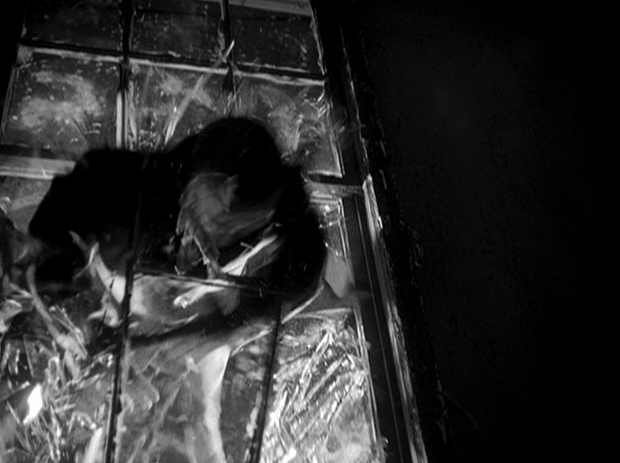
The plot of Orpheus involves his rescuing his wife, Eurydice, from Death and the Underworld, and one can look at Davey's journey in Killer's Kiss as possessing some of the same elements, he having to rescue Gloria from Vincent.
I think Kubrick is using, with the high contrast Badlands, that almost look like arctic ice rather than the desert, this same inversion that signals the underworld descent. You will also notice that the numbers on the license plate are normally white on a dark background, and this is inverted in the Badlands so the numbers are dark on a white background, as if confirmation of the negative/positive inversion.
Who is doing the rescuing, as Orpheus? Is Humbert, as Orpheus, trying to rescue from the underworld his original love Annabel? Do we see this again when Humbert visits Lolita toward the film's end and we have certain themes from here repeated there?
As seen above, another version of the hooded fgure again appears in a calendar showing an ice skater at Lolita's house where she discusses with Humbert her moving to Alaska with Dick.
But the hood is not simply a hood. As Dick, in The Shining, lies in Miami watching news on the blizzard that has blanketed Colorado in Arctic conditions (isolating the Overlook), we have the paintings of the women whose faces are framed by large afros.
We have much the same in the choking poster that appear s to show the face of a choking child in the middle of an O.
Moving on to Eyes Wide Shut, at Rainbow Fashions we have the Lolita-esque girl discovered with two Japanese men (again the Asian tie in), one of whom wears a wig that frames the face in the same spherical fashion.
This black wig on the Japanese man in his red thong is rephrased with the woman in the raven wig who steps forward to redeem Bill.
What I pay attention to are very specific differences from the literature, which become themes throughout Kubrick's films. A thread of resemblance weaves through these things which suggests a unifying vision had for them. I cover this more in The Shining as we have this particular theme used again and again in that film.
In the book, Dick Schiller's friend, Bill, has only one arm, he having lost the other in WWII due to injury by a jagger. In neither the screenplay nor the book do we have Humbert suffering, perhaps, a minor heart attack, though he does have heart problems, and I would argue that we have folded into him this characteristic of Bill, who retains both arms in the film. The problematic left arm seems to have an association with Humbert being kicked in his right arm when Lolita is climbing into the rear seat as she feels cold and wants a sweater. It is after this, and his divulging they are being followed, when they have the blow-out, the noise of which one could compare to a gun shot.
I'm not a big one for playing the numbers game with Kubrick, with the exception of 114 (and its permutations), 237 and 42/24, because Kubrick makes a point of them. Such as the license plate of the ambulance that arrived to ferry dead Charlotte away was 42Q, thus a variation on the 242 that was the Haze house number and the number of the hotel room at the Enchanted Hunters Hotel.
Nabokov is known to have played number games in his writing, but I know nothing about that.
If I pay attention to the licenses here, it's to point out the black and white inversion that happens with the blow-out, not to try to figure out anything to do with the numbers.
It's difficult to tell anything about the license plates with long shots of the car in the supposed American southwest (South Dakota). Long shots of the car arriving at Beardsley we definitely have the dark 17459 plates.
The first time I'm able to read a plate number is with the arrival at Camp Climax. The license here is 2197.
The license plate number at Beardsley is different from Climax, which would be appropriate for license renewal (6 months have passed), and is the same as it will be when they stop for gas and Humbert goes to the rest room, but it is also the same as it will be at film's end though time has marched on by a couple of years.
The car, by the way, is a Ford Country Sedan, 1957 model.
The number is the same as at Beardsley and when Humbert visits Lolita at film's end.
We're given a clear view of the license plate of the car with which Lolita is talking at the gas station. All we can see is a number. 4304. I suppose one could pay some attention to this as it exhibits the same circularity of 242 but is not 242.
At film's end, again, the station wagon has the same license as at Beardsley and the gas station. But the fog light, observed in shots of the car done in England, is only on the car that we see James Mason exit. The bridge shot, that leads up to James Mason exiting the car at the Schillers', and which was filmed in New York, has the 17459 license. This is a number that is used both in shots made in America and England, so it's not a matter of, "Oh, that number is because it was in England and a different number was used in America". That's not the case. The Beardsley, gas station, and Schiller house scenes are all in England, but the below is a Rensselaer, New York shot and it uses the same license number.
With the blow-out, we have dark numbers on a white background. The numer is different as well but, as stated above, I'm more interested in the dark and light inversion.

Kubrick settles down low on that road and gives us a strategic look at the plate. It's a great effect and ensures we don't see who's actually doing the stunt driving in the car. But he does focus on that plate.
Why would the 17459 license plate, which was used in America, not be used in the blown tire shot?
432 LS of hospital parking lot, Humbert baking into a parking place. (2:07:36)
433 MLS Hospital interior, Humbert entering with books and flowers. (2:07:41)
He passes by the front desk with a greeting, coughing.
HUMBERT: Good morning.
NURSE: Good morning, Mr. Humbert.
He continues on and runs into another nurse.
NURSE: Oh, good morning, Mr. Humbert. We seem to be going the same way. I was just about to give your daughter some medicine.
HUMBERT: How is she?
434 MLS Approaching Lolita's door. Number 3. (2:08:02)
NURSE: She's much better today. Her temperature's normal and her cough's gone.
435 MLS Lolita's room. (2:08:04)
NURSE: Here's your father, dear.
LOLITA: Hi!
HUMBERT: Hello.How are you feeling?
LOLITA: I feel fine.
HUMBERT: You're looking much better.
Lolita takes some medicine from the nurse.
LOLITA: What gruesome flowers. But thanks, anyway.
HUMBERT: Nurse, can you find some water to put these in, please?
NURSE (taking the flowers): Certainly.
HUMBERT (picking up an envelope from her tray): Have you been getting notes in the hospital?
NURSE (taking it): Excuse me. Does your father think that you get notes from my boyfriend?
HUMBERT (giving her the books): I just thought it might be a bill from the hospital or something.
LOLITA: Do you have to antagonize everybody?
HUMBERT: It was a perfectly reasonable question.
LOLITA: What's the matter with you anyway? You look kind of slimy.
HUMBERT: I'm afraid I'm coming down with a cold.
LOLITA: Caught it from me?
HUMBERT: I suppose.
436 MS Nurse returning. (2:08:59)
NURSE:
Mr. Humbert, would you please move your car...
437 MLS Humbert and Lolita. (2:09:02)
NURSE (off screen): ...to the visitor's parking lot?
HUMBERT: I'm sorry. I was in a hurry and I didn't feel too bright this morning.
438 MS Nurse. (2:09:05)
NURSE: But you've parked it...
439 MLS Humbert and Lolita. (2:09:08)
NURSE (off screen): ...right next to a sign saying "Staff Only".
HUMBERT: All right. All right. I shall be leaving in a moment.
NURSE (off screen): I'm sorry...
440 MS Nurse. (2:09:11)
NURSE: ...but these are the hospital rules.
441 MLS Humbert and Lolita. (2:09:13)
LOLITA: Mary was only trying to be helpful.
HUMBERT: Yes, I know that sort of help. I've no doubt she's been just as helpful with you all the time.
LOLITA: She has.
HUMBERT: And I shouldn't wonder if you two have been exchanging the crummiest of confessions.
LOLITA: Come on now, let's not start that all up again.
HUMBERT: I brought you some books. My friend, Professor Baer (Behr), "The Romantic Poets", and here's something you might like, "The History of Dancing", and "A Portrait of the Artist as a Young Man" by James Joyce, you might like. (Picking up some sunglasses off the tray.) Whose are these? These are not yours.
LOLITA: Those are Mary's.
HUMBERT: And since when have nurses worn dark glasses when on duty?
LOLITA: There we go again!
HUMBERT: When did the doctor say that you can leave the hospital?
LOLITA: What?
HUMBERT: Are you going to read the magazine or talk to me for a while?
LOLITA: Sure.
HUMBERT: When did the doctor say that you can leave?
LOLITA: I think he wants me to stay another 48 hours.
HUMBERT: That's all right. We can start early on Tuesday morning and we'll make the Mexican border in three days, and that'll be the end of all those mysterious agents...
442 MS Nurse. (2:10:24)
HUMBERT (off screen): ...following us around.
NURSE: Mr. Humbert, I must...
443 MLS Humbert and Lolita. (2:10:26)
NURSE (off screen): ...ask you to move your car.
HUMBERT: I'm just leaving.
444 MS Nurse. (2:10:31)
445 MS Humbert. (2:10:33)
LOLITA: Goodbye.
446 MCU Lolita. (2:10:36)
Humbert leans over to kiss her. She draws away. He gives her a kiss on the cheek.
LOLITA: Might catch your cold.
HUMBERT: I shall stay in tonight and nurse my cold, so I shan't see you until tomorrow morning.
LOLITA: Bye-bye.
447 MLS Lolita and Humbert. (2:10:53)
He waves bye, she does so as well. He turns to leave as the screen fades to black.
Shot 432 | Shot 433 |
 |  |
Shot 434 | Shot 435 |
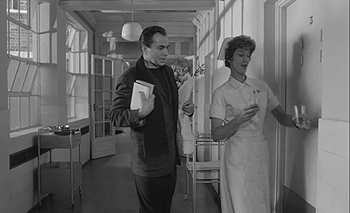 |  |
Shot 436 | Shot 437 |
 |  |
Shot 438 | Shot 439 |
 |  |
Shot 440 | Shot 441 |
 | 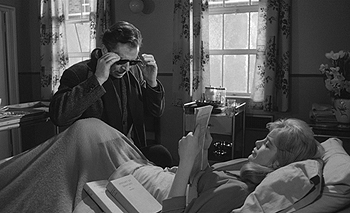 |
Shot 442 | Shot 443 |
 |  |
Shot 444 | Shot 445 |
 |  |
Shot 446 | Shot 447 |
 |  |
The hospital scene is much as it is in the screenplay.
An ill Humbert enters with the flowers and is told by the nurse he needs to move his car. We are given the impression that the nurse is indeed in league with Lolita as when Humbert notices the sunglasses she exchanges a quick glance with Lolita before saying a visitor left them, and when Humbert queries about the visitor she amends and says another patient had a visitor, she had found the sunglasses in the corridor and "thought they might be yours". Humbert has brought Lolita the books, History of Dancing and The Romantic Poets but not the book by James Joyce. Instead his other books are Flowers of the Rockies and Carmen by Merimee. An enthusiastic and desperate Humbert speaks of his plans to reach the Mexican border soon, after which he will make Lolita a "formal proposal" and get an old priest to bless them. Mary Lore (the nurse) enters at some point and hears a portion of the conversation, which Lolita explains is poetry and Humbert says is the only reality on earth. She has Humbert get her things from the car and he leaves.
In the book, an ill Humbert visits Lolita with flowers, Browning's Dramatic Works, The History of Dancing, Clowns and Columbines, The Russian Ballet, Flowers of the Rockies, The Theater Guild Anthology and a book on tennis. On a yolk-stained plate he notices a crumpled envelope with a "phony armorial design with 'Ponderosa Lodge' in green letters". He begins to look at it but Mary Lore, the nurse, glowers at him. He says he thought it was a bill. Mary says to Lolita, "Dolores, your pappy thinks you are getting letters from my boyfriend". Mary exits and Humbert talks to Lolita of leaving the town. Lolita wants her bags. He leaves but ends up not bringing the bags as he is bound in bed, sick.
At five minutes to two p.m. he gets a visit from Big Frank letting him know Nurse Lore is on the telephone wanting to know if Humbert is better and would he be by that day.
No.
The next day, feeling better, Humbert walks over to the office's telephone and finds out that Lolita had checked out the previous day, at 2 p.m., with her "Uncle Gustave".
ReelStreets.com gives the hospital as Albany Memorial Hospital in New York. I took a screengrab from Google. The hospital is much changed but identifiable.
Why this hospital? Because it's off Highway 9 and they were on Highway 9N earlier on their way to the Enchanted Hunters Hotel (as well as in the Black Hills)? Because it is near Van Rensselaer Boulevard and later, on the way to Lolita's, Humbert's car will be filmed on Partition Street in Rensselaer, New York, just across the Hudson River?
Wikipedia quotes from the Critical Companion to James Joyce: A Literary Reference to His Life and Work:
A Portrait of the Artist as a Young Man stands as Joyce's only published work preceded by an epigraph: Et ignotas animum dimittit in artes. The passage come from Ovid's Metamorphoses, and it can be translated as "he turned his mind to unknown arts." It records the response of Daedalus, the fabulous artificer, when tol by King Minos of Crete that he and his son would not be allowed to leave the island. Daedalus in turn produced the wax wings that allowed him and Icarus to soar away but that also led to his son's death when the young man flew too close to the sun and the wax melted. This epigraph traces wonderfully the narrative movement of each chapter, which ends on a high note only to be brought low by the depressing image or scene that introduces the next chapter...Further, a portrait by its very nature reflects as much of the perceiver as it does of the subject.
Hugh Kenner's plan of Joyce's Ulysses provides the following: that the hour of the 10th chapter, "Wandering Rocks", is 3 p.m., its technic is the labyrinth, and included in its correspondences is "Asiatic Bank" which is the Asiatic Bank of the Bosphorus.
I've already stressed in my other analyses of Kubrick's works that I think the myths of Daedalus appear repeatedly (maze, minotaur). The repetitive image since Humbert and Lolita have taken to the road again is wings. The winged A. Winged Pegasus. This could be a rephrasing of Icarus, Daedalus' son who was imprisoned in the maze with him in a curious parallel to the Minotaur having been imprisoned in the maze, the maze also having been used as confinement for its creator and his son.
It's Kubrick who has planted the Joyce novel in Lolita's things.
I'm more interested in Lolita being in Room 3 with the Asiatic Flu and Humbert soon trying to check her out at about 3:05 a.m. in the morning only to find she is gone. I see correspondences with the "Wandering Rock's" chapter of Ulysses which has 3:00 as its hour, the labyrinth is its technic, and a correspondance is the Asiatic Bank. I think it's also interesting that Kubrick has had the car (in rear screen projection) take what seems to be this swerving treacherous pass through the Badlands of South Dakota, which is not treacherous but is made here to look like it is, reminding of the treacherous Wandering Rocks.
Ulysses didn't pass through the Wandering Rocks, which would clash together and smash ships, but they are part of his story. The Wandering Rocks are linked to the Bosphorus, between Asiatic and European shores, because it too was a place where rocks crashed shut, thought of as the very edge of the world. Jason and the Argonauts only barely slipped through due having been given the tip that if they sent a dove ahead of them then the rocks would crash together in pursuit of the dove and when they opened up again afterwards they would have time to pass through.
I can see in this Humbert and Lolita's swift and swervy drive through this craggy Badland area and their having the blow-out as they reach the strait and narrow, as if they too only barely made it through but still would suffer some damage.
Several times, the contention with Lolita at Beardsley was where was she between the hours of 2 and 4 when she was supposed to be at her piano lessons with Ms. Starch, and here we have again the number 3 playing prominently with Lolita's final departure from Humbert.
The idea of the Bosphorus also works well as Kubrick tends to have a delineating center point in his films. For instance, in The Shining it's the Continental Divide, the passage to the Overlook taking us up to it from the left and the right, and the center of the World Maze being thus situated upon it. Here, if we have the Bosphorus, it's the edge of the world that is also the dividing line between Asia and Europe.
Not to be neglected is the knowledge that Lolita's real last name is Maze, the Haze name having been used to partially disguise her.
The Torrances are housed in suite 3 at The Overlook.
448 LS The car outside a row of motel cabins. (2:11:09)
We hear a phone ringing.
449 MLS Humbert in bed. (2:11:13)
The phone is ringing in his room. Coughing, he struggles out from under the covers, cutting on the lamp, a bare bulb, and grabs the phone, dropping it.
HUMBERT: Hello?
QUILTY (off screen): Hello. Is that Professor Humbert?
HUMBERT: Yes.
QUILTY (off screen): How are you, Professor?
HUMBERT: I'm... Who is this, please?
QUILTY (off screen): I'm sort of really sorry to disturb you. I hope I really haven't woken you at this terribly late hour. I was wondering if you'd been enjoying your stay in our lovely little town here.
HUMBERT: Who's this calling?
QUILTY (off screen): My name, oh, it doesn't really matter about my name. It's really an obscure and unremarkable name, you understand, Professor. But my department is sort of concerned, sort of concerned with the bizarre rumors...
450 MS Humbert. (2:12:23)
QUILTY (off screen): ...that have been circulating about you and the lovely, remarkable girl you've been travelling with.
HUMBERT: Look, I'm very much afraid you'll have to identify yourself because this conversation is becoming more and more preposterous.
QUILTY (off screen): Professor, now tell me something, I guess all this travelling around you do, you don't get much time to see a psychiatrist regularly, is that right?
HUMBERT: I have no psychiatrist, and I don't need a psychiatrist!
QUILTY (off screen): I'll tell you why I ask, you see, you're classified in our files, Professor, you're classified in our files as a white, widowed male. I wonder if you'd be prepared to give our investigators a report, Professor, on your current sex life, if any.
HUMBERT: Look, I don't know who you are, and I certainly have no interest in your investigators and therefore I'm afraid that you will have to terminate this conversation.
451 MLS Humbert. (2:13:16)
QUILTY (off screen): Professor, afraid is Freudian lingo.
Humbert hangs up the phone. Crossfade to the hospital parking lot, the car arriving.
Shot 448 | Shot 449 |
 |  |
Shot 450 | Shot 451 |
 | 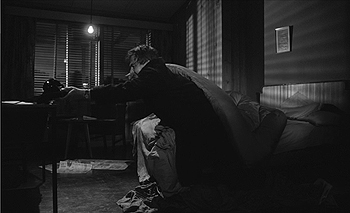 |
The conversation on the phone is quite different. Quilty answers, "Hi there, professor" showing immediately he knows him. When Humbert asks him what he wants, he replies, "I'm not sure what to call it. Cooperation? Surrender to fate?" Humbert isn't clear if he's speaking with an hallucination and complains about his tinnitus. Quilty answers he also has a bug and he figures they both caught it from her. Humbert asks, "From her? What do you mean?" Quilty replies, "Oh, lots of things are feminine--cars, carpets, car pets, haha! I've even heard a fireman refer to a fire as she." Finally, Quilty says he just wanted to make sure Humbert was safe in bed. Humbert demands if he's the person who has been following him. Quilty says that is finished, that he will be leaving in a minute with his niece, that he knows exactly what Humbert will do when he hangs up. Then he hangs up and Humbert calls the hospital room, Quilty answering. He says that he told him he knew he would do it, that "she's in my lap and quite lively" and hangs up. Already knowing, fearing that Lolita is being carried away, Humbert frantically goes to the hospital.
A delirious telephone conversation doesn't occur in the book.
The termination of the conversation could be perhaps compared with Jack taking apart the radio at The Overlook so that it is completely isolated.
452 LS The hospiral parking lot. (2:13:22)
453 MS From inside, Humbert entering the hospital. (2:13:27)
FROMKISS: Can I help you, sir?
HUMBERT: Yes. My name is Humbert. I want to pay the bill of Miss Haze who's in Room 3. I'm taking her home.
FROMKISS: Have you gotten permission from the doctor?
HUMBERT: I can do what I choose to do. It has nothing to do with the doctor.
FROMKISS: I'm afraid you have to have permission from the doctor.
HUMBERT: What is this, a prison or a hospital?
FROMKISS: I'm afraid you'll have to speak to Dr. Keagy. (On the intercom.) Calling Dr. Keagy. Dr. Keagy, come to Reception, please.
HUMBERT: I'll just go into her room to alert her.
FROMKISS:
No, you can't go in there.
HUMBERT: I'll get her to get her bags ready.
FROMKISS: Dr. Keagy will be down in just a minute. Why don't you wait?
454 MS Dr. Keagy, chewing on a sandwich. (2:14:12)
KEAGY: Yes, Miss Fromkiss?
FROMKISS: Dr. Keagy, Mr. Humbert.
KEAGY: Wow. How long have you had that cough, Mr. Humbert?
HUMBERT: I'm perfectly all right, thank you. I simply want to pay the bill for Miss Haze in Room 3 and take her away from here.
KEAGY: Haze, Room 3. Wasn't she discharged earlier this evening, Miss Fromkiss?
FROMKISS: I'll see.
HUMBERT: No, she couldn't have been.
FROMKISS: Yes, she was discharged at 8:15 this evening.
HUMBERT: That's impossible.
FROMKISS: Right here, she was discharged at 8:15.
The nurse that had asked him to move his car passes by.
HUMBERT: You, Nurse, what's your name? She's still in there, isn't she?
NURSE: Mr. Humbert, your daughter left earlier this evening.
HUMBERT: That's ridiculous. (Humbert charges to the door to the ward where Lolita's room was.)
KEAGY: Where do you think you're going?
Shot 452 | Shot 453 |
 |  |
Shot 454 | Shot 455 |
 |  |
455 LS Humbert entering the ward. (2:14:55)
KEAGY: Come back here, now. You can't go in there now, it's a hospital.
NURSE: Please, don't...
HUMBERT (grabbing her throat): Where have you put her?
ORDERLY (grabbing him): Get your hands off her!
HUMBERT: Where is she? Where is she?
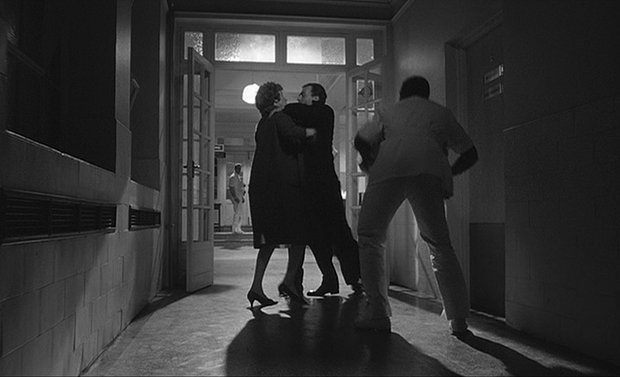
Keagy and two orderlies struggle with Humbert as he tries to attack the nurse.
KEAGY: Hold him!
HUMBERT: Let go of me! Let go of me!
KEAGY: What do you think you're doing?
NURSE: No! Hold it!
HUMBERT: Where is she?
ANDRE: Easy, now,easy.
KEAGY: Sidney! Get a straightjacket.
456 MLS Humbert held by the orderlies. (2:15:12)
HUMBERT: All right. I'm calm.
NURSE: Doctor, this man must be psychotic. His stepdaughter was a patient in there and she left this evening in care of her uncle.
HUMBERT: Her uncle! Did you say "uncle"?
NURSE: Yes.
HUMBERT: Let me go!
KEAGY: Hold him!
457 MLS Humbert struggling with the orderlies. (2:15:22)
NURSE: Oh! Wait!
Largely inarticulate cries as Humbert continues fighting, the orderlies wrestling him to the floor.
KEAGY: Hold him now. Got him, Andre?
ANDRE:
Yeah!
HUMBERT: All right. Let me go.
KEAGY: Now look, mister, you've caused quite a serious disturbance here. Now, hold it!
ANDRE: Easy.
KEAGY: Now, if you like, we'll call the police.
HUMBERT: The police! No, no, no. We don't need the police. It's quite all right.
KEAGY: All right. Let's get this business straight. This girl was officially discharged earlier tonight in the care of her uncle.
HUMBERT: If you say so.
KEAGY: Well, has she or hasn't...
458 MCU Humbert on the floor. (2:15:55)
KEAGY (off screen): ...she an uncle?
HUMBERT: All right, let's say she has an uncle.
KEAGY (off screen): What do you mean, "let's say she has an uncle"?
HUMBERT: All right, she has an uncle. Uncle Gus, yes, I remember now, he was going to pick her up here at the hospital. I forgot that.
KEAGY (off screen): You forgot?
HUMBERT: Yes, I forgot!
KEAGY (off screen): It's a strange thing to forget, isn't it?
HUMBERT: No, it's not so strange. You don't know my brother Gus. He's very easy to forget.
459 MLS The orderlies, Keagy and the nurse holding down Humbert. (2:16:20)
ANDRE: He's drunk, that's what's the matter with him.
HUMBERT: Yes. That's right, I've been drinking much too much. I have personal problems, you understand?
SIDNEY (with the straitjacket): Here it is, Doctor.
KEAGY: No, no, it's all right, Sidney.
460 MCU Humbert with the pen light in his eyes. (2:16:31)
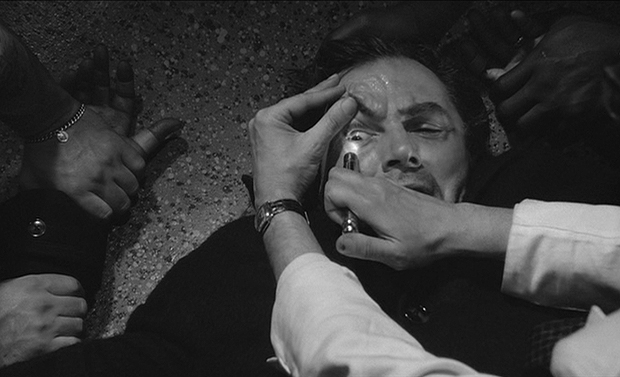
KEAGY (off screen): Would you like some black coffee or something?
HUMBERT: No, not now, thank you. I really ought to move on now.
461 MLS The orderlies, Keagy and the nurse holding down Humbert. (2:16:44)
KEAGY: Think you feel well enough to leave?
HUMBERT: Yes. Just let me up, I'm fine now, much better.
KEAGY: See that he gets home all right.
ANDRE: Come on.
Shot 456 | Shot 457 |
 |  |
Shot 458 | Shot 459 |
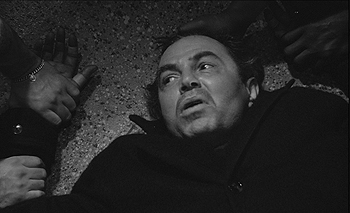 |  |
Shot 460 | Shot 461 |
 |  |
462 MLS to LS They assist Humbert to stand. (2:16:52)
ORDERLY:
All right, let him up.
Andre and the other orderly assist Humbert to the door, Andre grooming him, straightening his hair, brushing off his clothing.
HUMBERT (calling back): She didn't, by any chance, leave any message for me? No. I suppose not.
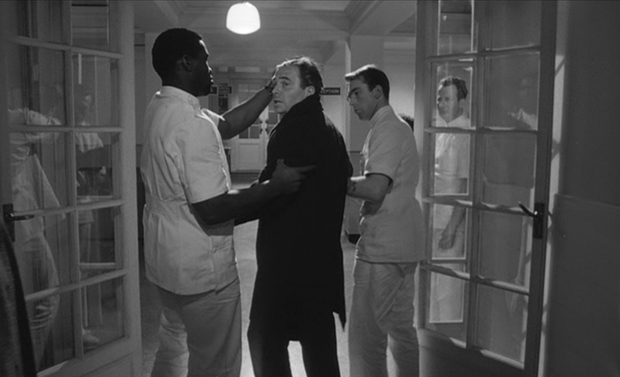
Fade to black.
In the screenplay, when Humbert reaches the hospital there is no Nurse Fromkiss with whom to deal, instead Mary Lore is there, and a Doctor Blue. Humbert calls for Lolita. Mary Lore says he knows perfectly well her uncle came for her. She explains to the doctor that Humbert is sick, doesn't know what he's saying, and that she had been warned the stepfather had a feud with the rest of the family. Humbert yells it's a lie, tries to grasp Mary, and we cut to his psychiatrist speaking about how Humbert spent months searching for Lolita, finally going to a sanatorium for his heart and mental condition. Eventually he was able to check out and return to Beardsley College.
In the book, Humbert arrives at the hospital already aware that Lolita has checked out with "Uncle Gustave". He tries to beat up the doctor, and clamors for Mary Lore who isn't there. He is presented with Lolita's books and a folded tartan lap robe that he had brought Lolita. Becoming aware of a policeman in the hallway, he meekly signs the symbolic receipt and leaves rather than making a false move that attract the policeman and then having to explain a life of crime.
A magnificent scene. It is heart-rending when it shouldn't be, when you don't want it to be, and there are a couple of reasons why, apart from James Mason being as incredible an actor as he is.
One is that Kubrick shoves most of the story line aside at this point so that instead it is a moment without history. A father (stepfather) has arrived at the hospital to pick up his minor daughter, and the hospital has already released her, without his consent, and then blames him when he goes mad. Kubrick shifts the bad guy blame away from the individual and instead to the institution. Two wrongs collide here. Because, despite what Humbert is and has been doing to Lolita, what the hospital has done is wrong. They know nothing about Humbert's sick relationship with Lolita. All they know is Humbert is her father. So, as far as the hospital would be concerned they are dealing with a father who is freaking out that his daughter is gone and rather than assuming responsibility for releasing a minor to the wrong party the hospital is threatening to wrap "dad" up in a straitjacket. The flagrant contempt and sense of superiority of the institution in its egotism retracks any hostility we may have for Humbert away from him and toward them. Humbert has tried throughout the film to keep all eyes averted from his relationship with Lolita, counting on his own superior ways as the respectable European professor. Now, he has become only the father (at least he is such in their eyes) and his rage is righteous but powerless.
The sacrifice of the individual for sake of the institution is in all of Kubrick's films.
Then, when Humbert is let go, we have the orderly, Andre, tending Humbert. He rather plays the parent role that Humbert never has with Lolita. Humbert has only ever done anything for Lolita in keeping with his fetishizing of her and ensuring her continued servicing him as his little sex slave. Andre is the only person in the film who plays the caretaker, who does something for a person without expecting a reward of some kind. Though he's just wrestled Humbert to the ground, as he stands him back up, helping support him to the door, he tenderly brushes the dust off Humbert's clothes and fixes his hair.
In The Shining, Jack's complete severance from any feeling but rage for Wendy and Danny happens during a Gold Room party in which Grady, as a waiter/caretaker, collides with him and gets Advocaat all over his jacket. Jack rubs some of the Advocaat on Grady's shoulder as Grady takes him into the bright red bathroom where he will clean Jack off. While he cleans Jack off, he encourages him to take care of his problematic family. And not take care of them as in be nice to them. There seems some comparison with this scene in which Humbert is separated from Lolita. Also, Wendy had been begging to take Danny to the hospital and Lolita is taken from the hospital.
So much focus on the eyes in Kubrick. There's the eye examination in Day of the Fight.
The light shone in Humbert's eye in Lolita.

Not quite the same in A Clockwork Orange, but there is also the image of the prison guard shining his light in Alex's face after using it to examine Alex' rectum. And then the forcing open of his eyes when he is being programmed.
And, of course, Danny's examination in The Shining after he has had his vision.
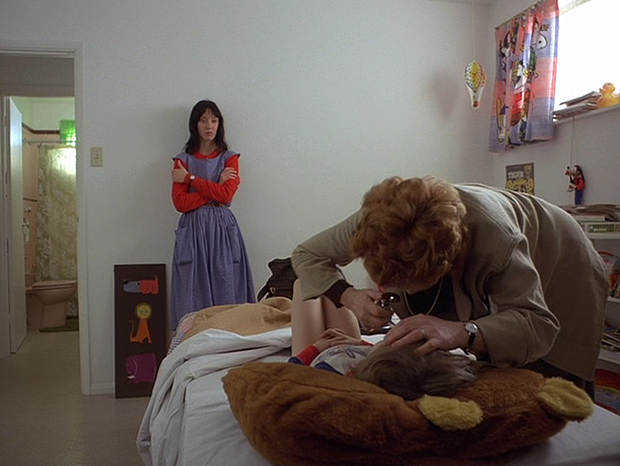
Kubrick keeps in the film that Quilty has identified himself as "Uncle Gustave" when checking out Lolita. Which says something about the nature of Quilty as Humbert's shadow, that here, as throughout the time of Quilty's following Humbert and Lolita, he uses names that will mean something to Humbert. How was Quilty to have known how profound was the significance of Uncle Gustave, who Humbert had, at one point, come to believe was following him?
The only time in the book that Nabokov suggests that Lolita might have told Quilty about Gustave is when Humbert is researching Quilty's shadowy trail, finding the hotels and motels into which he had checked as he followed them, recognizing him by his aliases and where he gives himself as living, all of which mean something to Humbert.
There was one strain running through all that pseudonymity which caused me especially painful palpitations when I came across it. Such things as "G. Trapp, Geneva, NY." was the sign of treachery on Lolita's part.
Kubrick's "Let's say she has an uncle", which is not in the book or screenplay, brings up an extra element of doubt about the uncle. But then the movie's audience knows nothing about Gustave, only about Quilty, and know that Quilty is the "uncle".
Nabokov many times said that his inspiration for Lolita was when he read of an ape who, given sketching materials, drew bars, meaning the cage in which he was imprisoned.
Keagy is also Kaegi which means a fence or hedge, and I think we can recognize the idea of the cage in this name.
The first little throb of Lolita went through me late in 1939 or early in 1940, in Paris ... somehow prompted by a newspaper story about an ape in the Jardin des Plantes, who, after months of coaxing by a scientist, produced the first drawing ever charcoaled by an animal: this sketch showed the bars of the poor creature's cage.
I find online that a poster to NABOKV-L, back in 1998, had attempted to sleuth out the ape story and had instead come up with several instances of apes taking pictures from inside their cages. One was a Life magazine story from 5 December 1949 in which was a letter from an H. Huber Clark about the first photograph taken by an ape. The person was responding to a story in Life on Nov 14th. They wrote, "Photographer Bernard Hoffman's Cookie was not the first ape to take a picture. My protogree, whose name was also Cookie, was an advanced shutterbug more than seven years ago when an article appeared in This Week magazine Oct. 11 1942." With the letter were a couple of photos: one of the first "Cookie" holding a Kodak, another of Cookie's supposed picture out of the bars of the cage.
Another person also wrote in. A Seaborn Jones Jr. of Jacksonville Fl, pointing out that Life had, on Sept 5 1938, published a picture of a chimpanzee in a zoo, holding a camera, alongside a photo the chimpanzee had supposedly taken.
First off, Nabokov's first Lolita was from about 1938, written in Russian.
Nabokov was likely aware of these Life magazine articles as, in another novel of his, Humbert is instead a Hubert H. Hubert, which would seem a play on H. Huber who had written the letter referring to the "first Cookie" (H. Huber Clark is in the 1940 census).
But here is what is more peculiar. What was on the page opposite the first letter, the H. Humber Clark letter? A letter from Nabokov himself.
Sirs: It may interest you to learn that the butterfly wings in the third panel of the Bosch triptych belong to a female of the common European species now known as Maniola jurtina, which Linaeus described some 250 years after Bosch knocked it down with his cap in a Flemish meadow to place it in his hell. Vladimir Nabokov
In another story, Nabokov describes Lolita's origin as being during an episode of a type of neuralgia that inflicts the rib cage, like the stitch in Adam's side, alluding to Lolita (Lilith) in the Garden of Eden. We certainly have her associated with the garden in the movie, screenplay and book. Nabokov's letter about the butterfly in Bosch's "The Garden of Earthly Delights", which features the garden as well as hell, seems to have blended with Huber's letter, opposite his, in producing the fiction of the ape who drew his cage in the Jardin des Plantes.
Which isn't to say we don't have cages all throughout Lolita, for we do, and Kubrick shows them, just as he shows the prospect of Humbert being straijacketed by Keagy in this scene.
Some of those cages?
The cage/fence enclosing the tiger and partly enclosing the portrait.
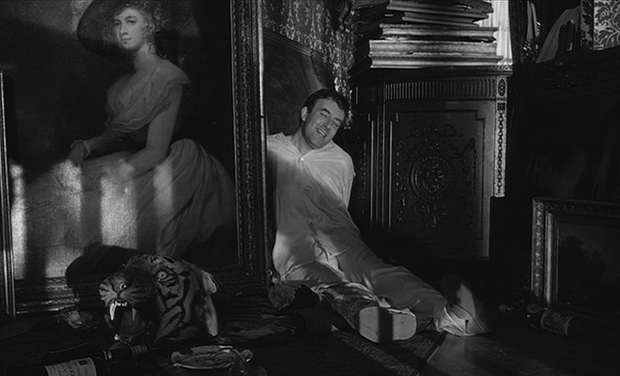
The fence/cage of the picket fence of the Haze household.
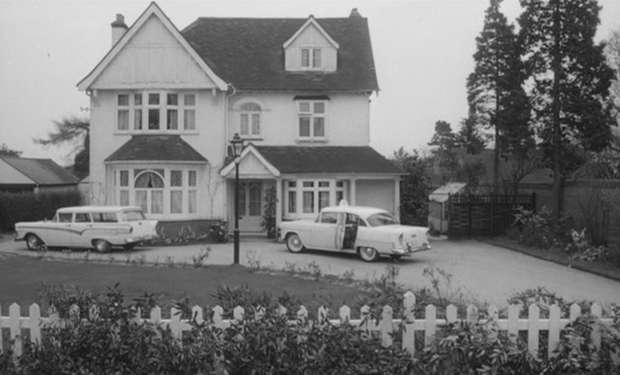
The fence/cage crushed by the car that kills Charlotte.
The cage of the hallway of 242, the Haze house.
The cage of the dining room.
The cage of room 242.
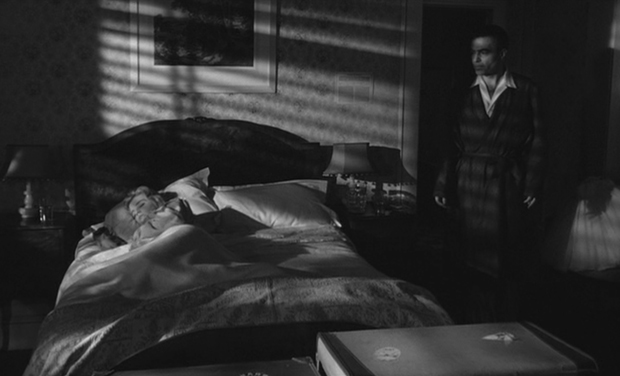
The cage of the motel before Humbert finds Lolita has disappeared.
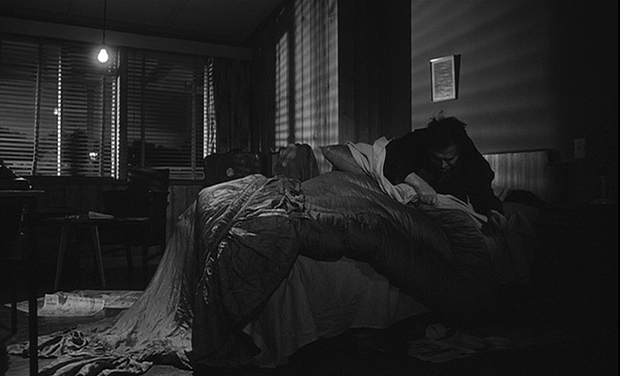
The Schiller's cage.
The cage of the picket fence just moments before Humbert and Lolita are shown to be followed.

And perhaps it is even found here.

For, above, with shot 411, I had compared the 3 shadows to the left with the 3 cigarettes in the Drome advertisement. And had then with 412 shown how Lolita's raising the veil relates to CRM-114, and its meaning as far as isolation, which is to be caged, something forbidden or kept safe.
November 2014 transferred to html. Originally posted sometime before 2012. Approx 11,100 words or 23 single-spaced pages. A 86 minute read at 130 wpm.
Go to Part 7
Go to Table of Contents of the analysis (and supplemental posts)
Link to the main TOC page for all the analyses